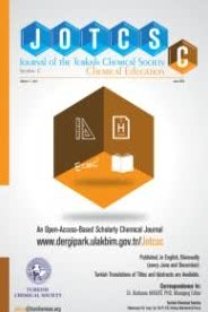10. Sınıf Öğrencilerinin Kimyasal Bağ ile ilgili Algıları, Kimyasal Bağı Tanımlamada Kullandıkları Metaforları ve Yaptıkları Benzeşimler
Bu çalışmada kimyasal bağlar konusunu öğrenmelerinden sonra, ortaöğretim öğrencilerinin kimyasal bağ kavramını nasıl algıladıkları, kimyasal bağı tanımlamada kullandıkları metaforları ile kimyasal bağı ne ile özdeşleştirdikleri araştırılmıştır. Bu amaçla geliştirilen iki aşamalı bir ölçme aracı kullanılarak, 184’ü kadın ve 113’ü erkek olmak üzere 5 farklı liseye devam eden toplam 297 onuncu sınıf öğrencisinden veri toplanmıştır. İlk aşamada öğrencilerin algı ve metaforlarını belirlemek için kimyasal bağı tanımları istenmiştir. İkinci aşamada öğrencilerin kimyasal bağ ile ilgili benzeşimlerini belirlemek amacıyla üzerinde “kimyasal bağı ……. benzer, çünkü…..” yazılı bir soru öğrencilere verilmiştir. Çalışma sonunda öğrencilerin kimyasal bağ algılarının 5 başlık altında ve metaforlarının da 6 kavramsal kategoride toplandığı belirlenmiştir. Öğrenciler tarafından yazılan benzeşimlerin analizi sonucunda, bunların da 7 tema altında toplandığı sonucuna ulaşılmıştır.
Anahtar Kelimeler:
Kimyasal Bağ, 10. Sınıf öğrencileri, Analoji
10th Grade Students' Perceptions about Chemical Bond, their Metaphors Used in Definition of Chemical Bond and their Analogies
In this study, after teaching the subject of chemical bonding how secondary school students perceive the concept of the chemical bond, which metaphors they use to define the chemical bond and what they associate with the chemical bonding were investigated. Data were collected from 297 tenth grade students attending 5 different high schools, 184 female and 113 male, using a two-stage measurement tool developed for this purpose. In order to determine the students' perceptions and metaphors, in the first stage of the scale, students were asked to define chemical bonding. In the second stage, A question containing the statement “chemical bond is like……. because ……” was given to the students to obtain their analogies about chemical bond. At the end of the study, it was determined that the chemical bond perceptions of the students were collected under 5 themes and their metaphors were collected in 6 conceptual categories. As a result of the analysis of the analogies provided by the students, it was concluded that these were collected under 7 themes.
Keywords:
chemical bond, 10th grade students, analogy,
___
- Arslan, M. M. & Bayrakçı, M. (2006). Metaforik düşünme ve öğrenme yaklaşımının eğitim-öğretim açısından incelenmesi. Milli Eğitim Dergisi, 171, 100-108.
- Asworth, P., & Lucas, U. (1998). What is ‘world’ of phenomenography? Scandinavian Journal of Educational Research, 42(4), 415-431.
- Birk, H. P. & Kurtz, M. J. (1999). Effect of Experience on Retention and Elimination of Misconceptions about Molecular Structure and Bonding. Journal of Chemical Education, 76(1), 124-128.
- Boo, H. K. (1998). Students’ Understanding of Chemical Bonds and The Energetics of Chemical Reactions. Journal of Research in Science Teaching, 35(5), 569-581.
- Büyüköztürk, Ş., Çakmak, E., Akgün, Ö. E., Karadeniz, Ş. & Demirel, F. (2009). Bilimsel Araştırma Yöntemleri (21. Baskı). Pegem Akademi: Ankara.
- Coll R. and Treagust D. F., (2001a), Learners' mental models of chemical bonding. Research in Science Education, 31, 357-382.
- Coll, R. K. & Taylor, N. (2002). Mental models in chemistry: Senior chemistry students’ mental models of chemical bonding. Chemistry Education: Research and Practice in Europe, 3(2), 175-184.
- Erdem, E., Yılmaz, A. & Morgil, İ. (2001). Kimya dersinde bazı kavramlar öğrenciler tarafından ne kadar anlaşılıyor? Hacettepe Üniversitesi Eğitim Fakültesi Dergisi, 20, 65 -72.Griffiths, A. K., & Preston, K. R. (1992). Grade-12 students’ misconceptions relating to fundamental characteristics of atoms and molecules. Journal of Research in Science Teaching, 29(6), 611–628. doi:10.1002/tea.3660290609.
- Gussarsky E. & Gorodetsky M. (1988). On the chemical equilibrium concept: constrained word associations and conception. Journal of Research in Science Teaching, 25, 319-333.
- Harrison, A. G. and Treagust, D. F. (1996) Secondary students’ mental models of atoms and molecules: implications for teaching chemistry. Science Education, 80(5), 509–534.
- Kelleci, G. (2014). Sınıf öğretmenliği adaylarının iklim kavramına ilişkin algılarının metafor yoluyla incelenmesi. Giresun Üniversitesi, Sosyal Bilimler Enstitüsü. Yayınlanmamış yüksek lisans tezi.
- Köseoğlu, P (2017). An analysis of university students’ perceptions of the concepts of “water” and “water pollution” through metaphors. Eurasia Journal of Mathematics, Science & Technology Education, 13(8), 4343-4350.
- Marton F. (1981). Phenomenography – describing conceptions of the world around us. Instructional Science, 10, 177-200.
- Marton F. (2005). Phenomenography: A Research Approach to Investigating Different Understandings of Reality, In: R. R. Sherman and R. B.Webb (eds), Qualitative Research in Education: Focus and Methods, London and New York.
- Nakiboglu C. (2003). Instructional misconceptions of Turkish prospective chemistry teachers about atomic orbitals and hybridization. Chemistry Education Research and Practice, 4, 171-188.
- Nakiboglu C. (2008). Using word associations for assessing non major science students’ knowledge structure before and after general chemistry instruction: the case of atomic structure. Chemistry Education Research and Practice, 9, 309–322.
- Peterson, R. F., Treagust, D. F. & Garnett, P. (1989). Development and application of a diagnostic instrument to evaluate grade-11 and -12 students’ concepts of covalent bonding and structure following a course of instruction. Journal of Research in Science Teaching, 26(4), 301–314.
- Taber, K. S. (1997). Student Understanding of Ionic Bonding: Molecular Versus Electrostatic Framework? School Science Review, 78(285), 85-95.
- Taber, K. S. (1998). An alternative conceptual framework from chemistry education. International Journal of Science Education, 20(5), 597–608.
- Taber, K.S., Tsaparlis, G. & Nakiboğlu, C. (2012). Student Conceptions of Ionic Bonding: Patterns of thinking across three European contexts, International Journal of Science Education, 34(18), 2843-2873.
- Tan, K. D. & Treagust, D. F. (1999). Evaluating Students’ Understanding of Chemical Bonding. School Science Review, 81(294), 75-83.
- Tóth, Z. and Ludányi, L. (2007). Combination of Phenomenography with Knowledge Space Theory to study students’ thinking patterns in describing an atom. Chemistry Education Research and Practice, 8(3), 327-336.
- Yildirim, A. ve Simsek, H. (2008). Sosyal Bilimlerde Nitel Arastirma Yontemleri. Ankara: Seckin Yayincilik.
- Başlangıç: 2016
- Yayıncı: Türkiye Kimya Derneği
